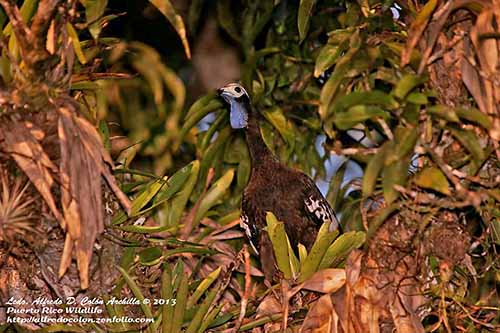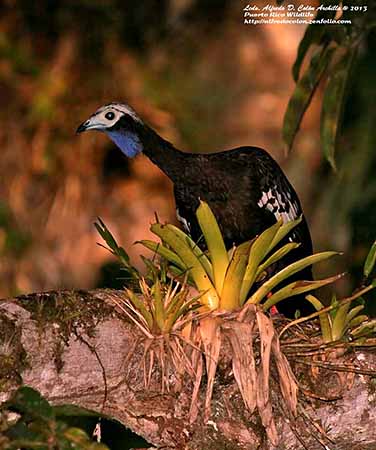
Fr: Pénélope siffleuse
All: Trinidadguan
Esp: Pava de Trinidad
Ita: Guan fischiatore di Trinidad
Nd: Trinidadblauwkeelgoean
Sd: Trinidadpipguan
Photographer:
Alfredo Colón
Puerto Rico Wildlife
Text by Nicole Bouglouan
Sources:
HANDBOOK OF THE BIRDS OF THE WORLD Vol 2 by Josep del Hoyo-Andrew Elliot-Jordi Sargatal - Lynx Edicions - ISBN: 8487334156
Hennache, A. & Ottaviani, M. (2005). Monographie des faisans, volume 1. Edition W.P.A. France, Clères, France. ISBN: 2-9512467-1-4
Hennache, A. & Ottaviani, M. (2006). Monographie des faisans, volume 2. Edition W.P.A. France, Clères, France.ISBN: 2-9512467-2-2
BirdLife International (BirdLife International)
Caribbean Birds - Society for the Conservation and Study of Caribbean Birds (SCSCB)
The Conservation Leadership Programme
Public Consultations on the Draft National Wildlife Policy
Trinidad Piping Guan
Pipile pipile
Galliformes Order – Cracidae Family
INTRODUCTION:
The Trinidad Piping Guan is endemic to Trinidad and Tobago. Heavily threatened by habitat destruction and illegal hunting, this beautiful bird has not well protected small population, and declines are continuing.
This is an arboreal species living in remote areas in the primary forest.
DESCRIPTION OF THE BIRD:
Biometrics:
Length: 61-69 cm
Weight: 2500-3300 g
The adult has dark brownish plumage overall with purplish-brown gloss, except the large white wing patches on the upperwing-coverts. The breast may sometimes show indistinct white markings. The long tail is dark brownish too.
On the head, we can see a dark, large, shaggy crest with white streaking. The facial skin, including the cere and the base of the bill, is pale blue, whereas lores and broad eyering are mostly white to pale bluish-white. There is a darker blue dewlap on chin and throat area.
The bill tip is black and the cere is pale blue. The eyes are dark brown. Powerful legs and feet are bright pinkish-red.

Both sexes are similar, but the male has slightly larger white wing patch than female.
The juvenile is much browner than adults, and shows less extended white markings on head and wing-coverts.
RANGE:
The Trinidad Piping Guan is endemic to Trinidad.
HABITAT:
The Trinidad Piping Guan frequents the remote primary forest areas on Trinidad, but it probably avoids the drier western areas. It is mainly found in sites with sparse ground cover and closed vegetation with vines and epiphytes.
Currently, this species is found in a patch of evergreen seasonal and montane forest in the eastern part of the Northern Range of Trinidad. It occurs from almost the sea-level up to the highest parts. It can be observed in deep forest and in disturbed edge habitat.
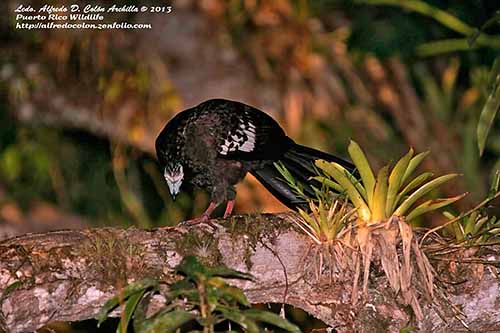
CALLS AND SONGS: SOUNDS BY XENO-CANTO
The Trinidad Piping Guan utters a single-note whistle “pee-oo”, which is probably a contact call. Soft quacking calls are given in series.
The song is often given from a perch in tree, and strangely, the voice is similar to that of a songbird. The commonest song is a series of 3-7 plaintive, monotone, flute-like whistles rising in pitch and lasting about five seconds.
This song is usually uttered while the bird is performing the wing-whirring display. This display includes a single, loud “clap”, and then we can hear 4-6 introductory “claps”, followed by a long burst of drumming while the bird is gliding in the air around the dawn.
BEHAVIOUR IN THE WILD:
The Trinidad Piping Guan spends most of its time in the forest canopy, and it is rarely seen on the ground.
It feeds on fruit and seeds from trees such as Cecropia peltata and Virola surinamensis, both native plant species. But it also takes fruits and seeds from introduced trees too.
Its diet also includes leaves, vines and flowers. Insects are occasionally caught. It gets water mainly from forest epiphytes (bromeliads), and from streams.

The Trinidad Piping Guan usually forages in small groups of 5-6 birds in the evening, including sometimes 1-2 hours after nightfall.
They are gregarious birds often seen in pairs or in small groups, but also as solitary birds. They are usually seen at top of emergent trees, often at forest edge.
The Trinidad Piping Guan raises its crest in aggressive behaviour while two birds are facing each other, and jumping at each other several times before separating. It also performs drumming displays. These sounds are produced mechanically by the wings, while the bird flies from tree to tree, and mainly in the early morning. These displays are more frequent during the breeding season.
The bird takes off from a tall tree and glides in the open for about two seconds. The wing-whir is produced during three seconds by beating the wings twice as fast as in normal flight. Then, the bird glides to another perch, usually a lower one.
Such flights occur over short distance, between 50 and 175 metres. The same bird performs this display several times in the same session, and uses several different perches.
The wing-whirring of the Trinidad Piping Guan can be heard more than a kilometre away. This display is used to maintain the pair bonds, but probably in pair formation too. It seems to be performed mainly by the males.
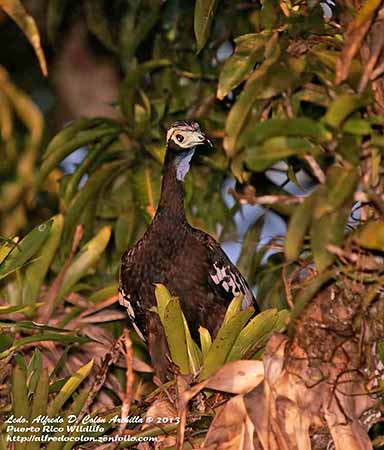
The Trinidad Piping Guan is resident in Trinidad, but the birds of the Northern Range perform local movements according to the food resources.
REPRODUCTION OF THIS SPECIES:
The breeding season takes place during the dry season, between January and June. But records of breeding activity are reported in most months.
The nest is a platform made with sticks, placed within tangle of vegetation, fairly close to the ground.
The female lays 2-3 white eggs and incubates alone, while the male remains in the vicinity of the nest for protection. It does not take part in nesting duties. The chicks are precocial.
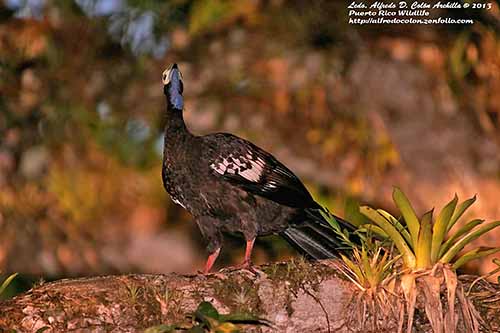
PROTECTION / THREATS / STATUS:
The Trinidad Piping Guan has small population estimated at 70-200 individuals. Declines of this species are due to high level of hunting, destruction and habitat loss within the restricted range. In addition, the remaining population is not well protected.
However, the hunting pressure has reduced due to recent education campaigns, and there are recent sightings of this species in areas from which it had disappeared since several decades, suggesting a small increase of population.
But currently, the Trinidad Piping Guan is listed as Critically Endangered.
